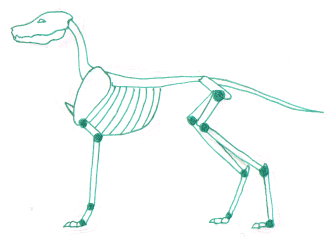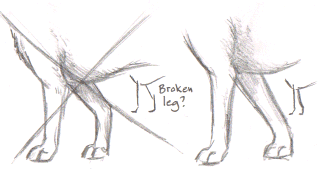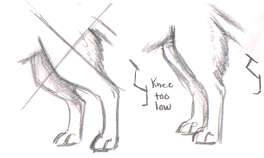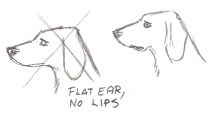Notes on drawing canines... Know what you're drawing!
![]()
When drawing canines, especially realistic ones, it really helps if you have some basic knowledge on anatomy! You don't have to know every single muscle and part of the skeleton, but knowing how and where the legs bends, the basic shape of the canine body, really helps, you know. I don't know that much myself, but I've learnt more and more. Now, when looking at many of my older pics, I realize what stupid anatomic mistakes I did back then!

Step 1 - The basic skeleton
This is a basic canine skeleton. As you probably realize, I've simplified it
quite a bit. But basically, this is what you need to know unless you want a very
realistic picture! Look at those filled balls on the legs... Those are joints,
that's where the leg can bend. Look at the foreleg first. First, we have the
shoulder, then the elbow. As you can see, the upper part of the dog's arm is
very short, and the elbow is placed very high. Well, that makes perfect sense if
you know what a speedy predator should look like. Long legs, right? Well, partly
truth, but it also depends on what part of the leg is long... The thigh? Nope,
it's the lower parts of the legs that tells you if an animal is a good runner or
not! Just look at a horse, or an ostrich! They have long legs, but the thighs
aren't the longest part of the legs! Same goes for dogs (well, at least the
speedy breeds). You can see that on the hind legs as well, the knees are placed
very high!

Here's the skeleton of an english bulldog. This dog isn't nearly as athletic as
the doggie above, but you can see that the basics are still the same, the length
and proportions have simply changed.
Whenever you want to try a pose, or just sketch, it's a great idea to use the
simplified skeleton. Heck, you can make it even simpler than above, just use
lines! The important thing is to keep all the joints, so that you can tell
whether a pose is anatomically correct!
![]()
What the? Common mistakes...
I will now go through some mistakes that one can do when drawing dogs. They
can be mistakes that I've seen others do, but most are mistakes that I've done
myself. Hopefully I will be able to teach you something :)

Strange bends
Sometimes you can see dogs with their legs bend at weird angles. You might
not realize it yourself at first, but if you look closely, and compare with our
trusty skeleton, you realize that this dog must have a broken leg to stand like
that!
Look at the first leg... It might look okay at first, but hey... How can it bend
on the middle like that? If we drew a skeleton onto that dog, we see that the
leg must be broken or something....

Low knees
Something else you often see... Low knees! Remember what I told you about
running abilities? Well, be honest... Do you think the dog to the left would be
able to run for long distances? I doubt it! Look at the skeleton... Poor doggie,
I wouldn't wanna be built like that!
Now, the dog to the right is another matter. Compare the two skeletons... As you
can see, this dog's knee is placed a lot higher, by the belly. This goes for
most "real" dogs, feel on a dog's hind leg, and you'll see it (well, feel
it). Okay, the american german shepherd has a low knee, but that poor breed has
been bred too far, and I honestly feel sorry for some of the german shepherds in
the US... You know, it's no wonder that they have more hip problems than other
breeds! If you live in the US, you should be aware that from all german
shepherds have THAT bent legs. FCI countries (the largest kennel organization in
the world) follow another breed standard, the german, which doesn't want such
bent legs (the american standard want the knee joint to be bent at 90 degrees,
which isn't healthy for any dog). I may be dissing someone here... Sorry in that
case, these are just my thoughts. Don't hate me >_<; *hides*

Teeth
Now, there are a few exception, but dogs with a "normal" bite, like
spaniels and other dogs with longer muzzles, usually have their teeth placed
like below. That means that the lower canine goes before the upper one,
not the other way around, as you often see! Dogs need their teeth placed like
this to help them nibble on small objects, like removing fleas from their coat.
It also helps them when biting.

Let's face it...
Dogs that have lips should be drawn with them, not like the dog to the left,
which has a giant mouth but no lips!
Also, the ears... Ears are not flat, they are as 3D as any other part of the
dog! Try to take a close look at a real dog's ears, that's the best you can do
:)
Well, these were a few tips of
mine. I hope that I've managed to help someone :)
If you have any questions, you can always email me!
![]()